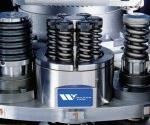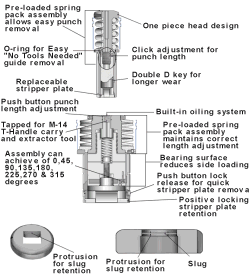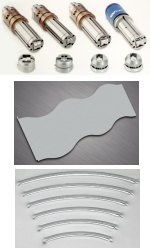What's New In Turret Punch Press Tooling
Fabrication shops are continuously pressured with demands for better delivery, improved quality and tighter tolerances. Tooling plays a major role in accommodating these market-driven demands. Here's how one major supplier is approaching the tooling needs of sheet metal shops.
Share



.png;maxWidth=45)
DMG MORI - Cincinnati
Featured Content
View More



Autodesk, Inc.
Featured Content
View More
From its beginnings in the 1950s, the turret punch press has evolved into a versatile and vital tool for fabrication shops. The marriage of CNC to the machine has pushed its usefulness even further.
Paralleling the technological development of the turret punch press has been the tools that do the sheet metal fabricating work. Driving developments in tooling are demands from fabrication shops to get more productivity from existing resources.
The sheet metal fab shop, like virtually all metalworking businesses, is faced with seemingly relentless pressure on its margins. Customers of all shapes and sizes are swinging the cost-cutting ax with a vengeance. Fab shops find themselves squarely in the path.
To find out how turret punch press tooling is helping fab shops improve their productivity, we talked to Ken Herreid, marketing specialist at Wilson Tool (White Bear Lake, Minnesota). Wilson is a leading manufacturer of punch tools for most of the world's turret punch press machine builders.
Punch Tool Basics
Tooling for a punch press consists of a punch, die and stripper. The punch is located in a guide mechanism that fits in the turret on a turret punch press. Turrets hold a variety of tools and index to bring different punch tools into the workzone of the machine.
Each punch tool has a corresponding die that is located under the machine tool's worktable. The size and shape of the hole created in the sheet metal is determined by the geometry of the punch. Clearance between the punch and die is adjusted to reflect the material thickness.
When the punch press is actuated, a ram descends, causing the punch to knock out the material creating a slug. The die is designed to allow the slug to fall through. The stripper holds the sheet metal in place until the punch is fully withdrawn from the sheet.
Most sheet metal punch tools used in shops today are self-stripping. Instead of using the ram to push the punch through the material and pull it out, these tools are built with an internal spring that automatically retracts the punch. The ram then only needs to work in one direction. This saves cycle time and wear on the turret punch press.
Development Drivers
Most of the more recent improvements in CNC punching technology have been focused around the need to improve productivity. While much effort has been directed to making the machines go faster, thereby reducing cycle time, additional consideration has been directed to looking at time savings across the entire sheet metal fabrication process.
These innovations have been demanded by job shops, and original equipment manufacturers are responding to their customers' demands for shorter order turn around, tighter tolerance specifications and delivery that coordinates with just-in-time inventory control systems.
Moreover, advancements in the simplification of sheet metal manufacturing, with the use of CNC and user friendly programming systems, has helped shops respond to the shortage of qualified workers. Many of the skills traditionally required to set up and operate punch presses are being incorporated in software and hardware that is designed to simplify the operation.
Push Button Setup
In the area of setup, tooling innovations have provided significant throughput improvements for fab shops by reducing the complexity of setting tools. Simplified punch length control is a technical improvement in tooling design that has had an impact on punch tool setup.
Part of the setup procedure for turret punch press tooling involves setting the stroke of the punch. This is especially critical when installing a punch that has been re-sharpened.
Grinding the punch removes metal and therefore affects overall length of the punch. To compensate, shims were used in the punch guide assembly to bring the tool back to its optimum length. That process obviously is time consuming.
Current tool design has made compensating the punch a much simpler job. These new tools use a push button adjusting system. Fine increments of 0.0001 inch eliminate the need for shims and make the tool setup consistent and fast.
In the stripper plate, rather than requiring screws or other fasteners to hold it in the guide, a push button locking system is used to secure the plate in the guide assembly. This system eliminates the need for installation tools, and together with shimless adjustment, can reduce setup by 15 minutes per tool. For a 30-tool capacity machine, that's significant.
Tool Life
The punching process generates heat. There is friction between the punch and the guide assembly as the punch reciprocates within its bushings. Modern turret punch presses are capable of 1,000 strokes per minute.
Most punch presses are equipped with, or have available, an automatic oil lubrication system. It supplies an air-oil mist through ports in the guide assembly to lubricate the moving parts in the tool. This significantly extends the life of wear parts within the punch tool.
Coating the punch is another method used by tool manufacturers to get more life from a tool grind. Hardness and smoothness are key to longer tool life, and currently titanium carbo-nitride (TiCN) is used for this property.
Punch hardness of 90 Rc is available using this coating. Because of their geometry, coated tools can be reground without losing hardness.
Another property of the TiCN coating is that its smoothness helps with lubricity. This is well applied on jobs where oil is considered a contaminant. Shops making parts for food processing or parts that will be painted or coated are better left without an oil film.
Doing More
Shops are always on the lookout for more and better ways to increase the productivity of their sheet metal fabrication operations. Combination tools, made possible by the application of CNC technology, are one tooling technology that has extended the productivity of the turret punch press.
Literally a turret within the turret, these tool clusters can be programmed to index to punch position, and they can be set up to provide 360 degrees of freedom for orientation of the punch tool tip. A single tool station on the turret can effectively bring several tools into the operation without indexing the turret.
Working in three dimensions is another application advancement being made in sheet metal fabrications. Increasingly shops are using the turret punch press to create 3D shapes in the workpiece that traditionally would be stamped in a secondary operation.
To make 3D shapes on a turret punch press, the raised form must be created up or away from the worktable. Since the sheet is manipulated under the turret, a 3D feature would create interference.
Therefore, when creating 3D forms on a punch press, the relationship of the die and punch is reversed. A hydraulic lift located under the die is actuated to raise it toward the punch. The total forming height is generally around 0.5 inch as measured from the top of the sheet metal to the top of the form.
Although the height of forms that can be produced on a turret punch press is limited, the ability provided by the machine and tool is a boon to shop productivity. If relatively high, complex forms can be done on the punch press, and that's one less manufacturing step the fab shop needs to consider.
A Wheel Of An Idea
In recent years, the wheel tool has proven to be a versatile addition to the fabricator's arsenal of tools. It's designed to work in a turret punch press, but unlike other tools, it's not a punch.
Instead, a rolling knife, not unlike a pizza cutter, mounts in the machine turret and is held down in position by the hydraulic ram. A die is also used and locates in its usual position under the sheet metal.
This tool cuts sheet metal at the machine's highest traverse rate. For shearing operations, the wheel tool cuts as fast as the sheet metal can be pulled under the cutter by the punch press.
In addition to shearing, the wheel has been developed into a variety of other application uses that can score a sheet for breaking, roll an integral rib for stiffening and roll an offset. Used in conjunction with an auto-indexing tool station, the wheel can be used to shear forms and contours.
Up to the wheel's operating thickness limit of 0.092 inch in aluminum, it can cut large diameter holes without the need for nibbling. A new design for these tools allows their use on mechanical punch presses. Like the clicker on a ball-point pen, the ram lowers the tool with a stroke and raises it with another when the cut is finished.
Other Trends
The punch press continues to evolve in terms of speed and power. Tooling development is moving in tandem with these machine tool innovations. Higher tonnage machines allow shops to punch thicker sheets. Heavy-duty tools with more punch travel can be used in sheet metal material up to 0.5 inch thick.
Speed too is a consideration for the shop, and innovations such as Wilson's slug hugger dies allow shops to go faster. In this die, small bumps on the inside edge of the die act to keep a punched slug from pulling out of the die at high speed.
Progressive tooling is an innovation that takes advantage of the punch press turret capacity. A single combination tool station can be used to perform a multiple-step punching operation that traditionally would have been done on a stamping press.
In general, innovations and advancements in machine technology and tooling application are creating a better fabricator. That's good for the shop and good for the industry.
Read Next
Registration Now Open for the Precision Machining Technology Show (PMTS) 2025
The precision machining industry’s premier event returns to Cleveland, OH, April 1-3.
Read More5 Rules of Thumb for Buying CNC Machine Tools
Use these tips to carefully plan your machine tool purchases and to avoid regretting your decision later.
Read MoreBuilding Out a Foundation for Student Machinists
Autodesk and Haas have teamed up to produce an introductory course for students that covers the basics of CAD, CAM and CNC while providing them with a portfolio part.
Read More























.png;maxWidth=150)















.jpg;maxWidth=300;quality=90)












